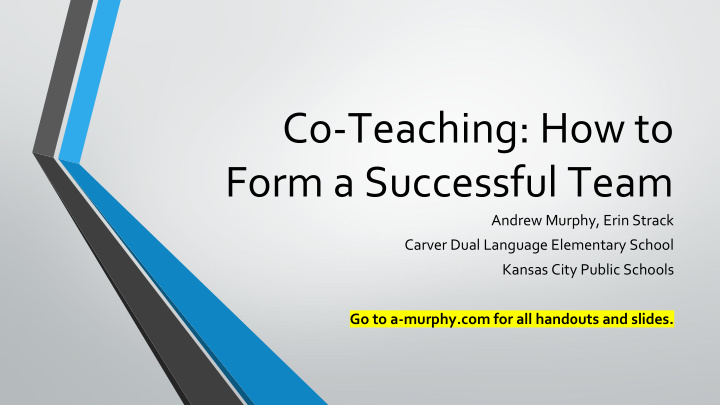



Co-Teaching: How to Form a Successful Team Andrew Murphy, Erin Strack Carver Dual Language Elementary School Kansas City Public Schools Go to a-murphy.com for all hand0uts and slides.
Objectives • Participants will become familiar with 6 different types of co-teaching and identify which type might work best for their instructional setting. • Participants will explore the necessary habits of an effective co-teaching team, as well as identify the destructive ones. • Participants will take part in the co-teaching process in order to experience the benefits it can offer.
What is Co-teaching and Why do it? Because….. Co-teaching is….. • All students can receive differentiated instruction • Two teachers with specific training and • It removes the stigma of student separation or experience identification • No instruction is missed, less fragmentation of • Delivering instruction together in the curriculum same space • It reduces the teacher-student ratio • Coordinated Instruction • Teachers learn from each other • More than just two teachers in the same • Less time is wasted, fewer interruptions room
Thomas and Collier- source Thomas and Collier, 2002
Collaborative Practices Lorem 1 Lorem 2 Lorem 3 Before Instruction During Instruction After Instruction - Joint Planning - Co-teaching - Collaborative Assessment of - Curriculum - Formative Student Work Mapping and Comprehension Alignment Checks for Content - Joint Planning for and Language Next Steps (reteach - Co-development of Objectives objectives or move Instructional on) Materials Modified from Honigsfeld and Dove (2010)
Before Instruction Lesson Planning SS & Reading Accountable Spelling Assessment Date Objectives Whole- Small-gro Vocab Words Talk Skill/Flocabulary (Quest of the Reading Group up Text Principles Words Wk) Language Text Social Studies 9-12 I can figure out the main Ch. 5 Local The Track Why are Capable idea in informational texts. County Backpack Agree Section taxes Developed Commission Tax (A-Z, Disagree 3 Disclose important I can understand and er Level O) Extraordinary to our explain citizens’ rights and City Council Invisible RT: A responsibilities. Candidate Manufacture economy? More Conflict Master Mature Perfect I can explain how taxes Compromise Practice provide goods and services Union Variety to people living in the taxed area.
During Instruction Six Models of Co-Teaching • One Teach, One Observe : One teacher is in charge of delivering instruction while the other collects data on one or a group of students • Station Teaching : Teachers divide content and both deliver instruction to small groups, or provide same content for longer, students cycle through Friend & Cook, 2013
During Instruction Six Models of Co-Teaching • Parallel Teaching : Teachers jointly plan and deliver the same instruction at the same time to half the class • Alternative Teaching : One teacher works with a small group with specific needs to pre-teach, re-teach, or enrich, other teacher instructs large group Friend & Cook, 2013
During Instruction Six Models of Co-Teaching • Teaming : Both teachers share instruction • One Teach, One Assist : One teacher provides instruction while the other assists students with questions Friend & Cook, 2013
After Instruction
After Instruction
“Be a good human!” -Andrew
Conflict Resolution Styles Accommodative Style Competitive Style Avoidance Style Compromising Style Consensus through Collaboration Style What is your conflict resolution style? What is that of your partner teacher’s? Know yourself, know your teammate. Friend & Cook, 2013
Viewpoints and Questions (Stations) Viewpoints: • Classroom teacher • ESL teacher • Read article and discuss Go to a-murphy.com for all hand0uts and slides.
Forming a Successful Team • Consider your co-teaching team • What method of co-teaching do you want to try? • Consider your student population, curriculum, time for planning, and instructional comfort level • How will you group your students? • What will each teacher’s primary responsibility be? • When will you meet to plan? • What problems might you face? • Teacher readiness checklist Go to a-murphy.com for all hand0uts and slides.
References • Friend, M., & Cook, L. (2013). Interactions: Collaboration skills for school professionals (7th ed). Boston: Pearson. • Honigsfeld, A. & Dove, M. (2010). Collaboration and Co-Teaching: Strategies for English Language Learners . California: Corwin. • Honigsfeld, A. & Dove, M. (2015). Collaboration and Co-Teaching for English Learners: A Leader’s Guide . California: Corwin. • Honigsfeld, A. & Dove, M. (2018). Co-Teaching for English Learners: A Guide to Collaborative Planning, Instruction, Assessment, and Reflection . California: Corwin. • Thomas, W. & Collier, V. (1997). School Effectiveness for Language Minority Students. NCBE Resource Collection Series, No. 9. National Clearinghouse for Bilingual Education. Washington, D.C.: Center for the Study of Language and Education. Go to a-murphy.com for all hand0uts and slides.
Recommend
More recommend